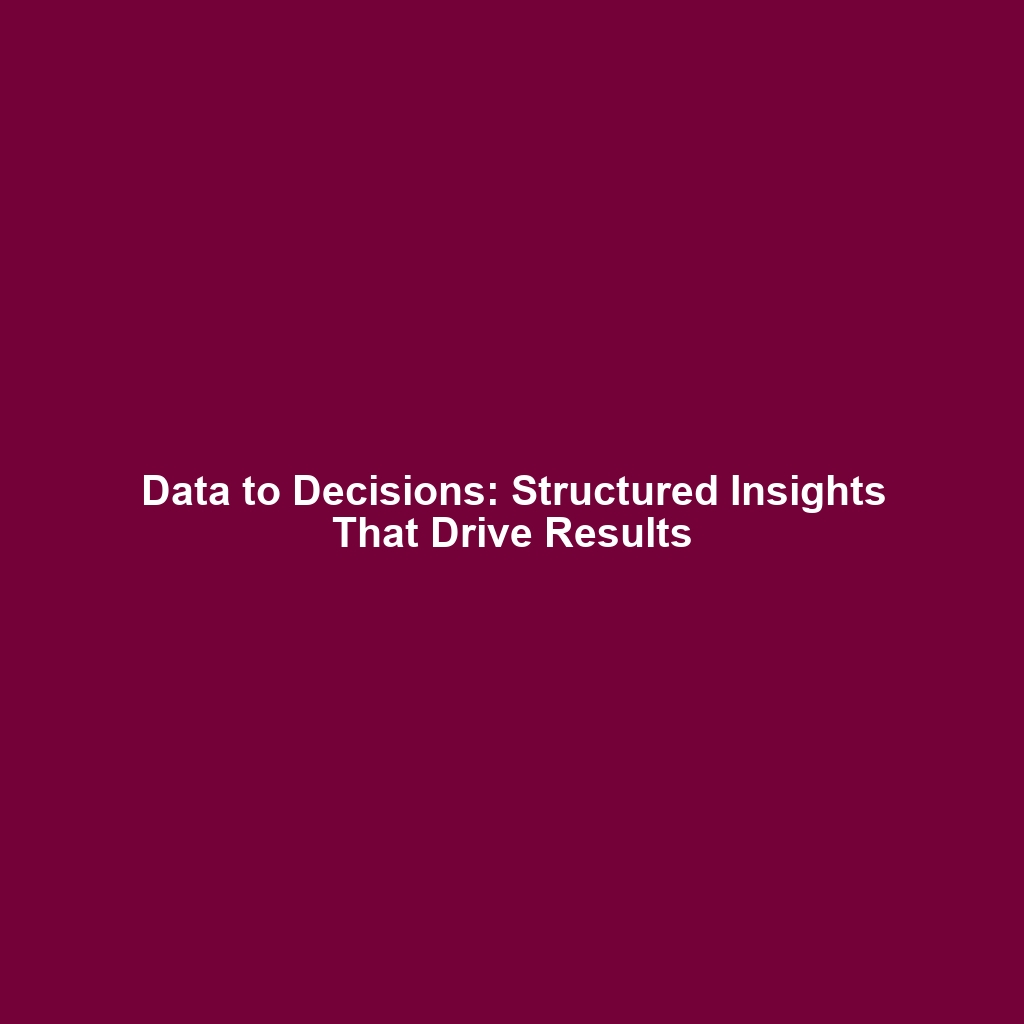The Data Deluge and the Decision-Making Dilemma
We’ve all heard the statistics: data is growing exponentially. But simply having more data doesn’t automatically lead to better decisions. In fact, it can often lead to paralysis by analysis. Without a structured approach, data analysis can become a time-consuming, unfocused exercise that yields little more than confusion and wasted resources.
Consider a marketing team struggling with declining conversion rates on their website. They have Google Analytics data, CRM data, social media engagement metrics, and customer survey results – a mountain of information. Without a structured approach, they might get lost in the weeds, chasing irrelevant trends and ultimately failing to identify the root cause of the problem.
Key Insight: Data without structure is just noise. Structured thinking provides the filter needed to extract valuable signals from the noise.
The Pitfalls of Unstructured Data Analysis
Unstructured data analysis can lead to several critical pitfalls:
- Confirmation Bias: We tend to seek out and interpret data that confirms our existing beliefs, even if it’s not the most accurate or complete picture.
- Overfitting: Finding patterns in the data that are specific to that dataset and don’t generalize to other situations. This leads to inaccurate predictions and poor decision-making.
- Correlation vs. Causation Confusion: Mistaking a correlation between two variables for a causal relationship. Just because two things happen together doesn’t mean one causes the other.
- Lack of Focus: Spending too much time analyzing irrelevant data, distracting from the real issues.
- Analysis Paralysis: Becoming so overwhelmed by the data that you’re unable to make any decision at all.
These pitfalls highlight the critical need for a structured approach to data analysis, one that emphasizes critical thinking, logical reasoning, and a clear understanding of the problem you’re trying to solve.
Structured Thinking: A Framework for Data-Driven Decisions
Structured thinking is a systematic approach to problem-solving that emphasizes clarity, logic, and evidence. It provides a framework for breaking down complex problems into smaller, more manageable components, analyzing those components in a rigorous and objective manner, and synthesizing the results into actionable insights.
At its core, structured thinking involves the following steps:
- Define the Problem: Clearly articulate the problem you’re trying to solve. What question are you trying to answer? What decision are you trying to make?
- Gather the Relevant Data: Identify the data sources that are most likely to provide insights into the problem.
- Structure the Data: Organize the data in a way that makes it easier to analyze. This might involve creating tables, charts, or other visualizations.
- Analyze the Data: Apply appropriate analytical techniques to identify patterns, trends, and anomalies.
- Synthesize the Insights: Draw conclusions from the data analysis and formulate actionable recommendations.
- Communicate the Findings: Clearly and concisely communicate the findings to stakeholders, using visuals and storytelling to make the data more accessible and compelling.
- Implement and Evaluate: Put the recommendations into action and track the results to measure their effectiveness.
This iterative process allows for continuous improvement and adaptation based on real-world results.
Common Structured Thinking Frameworks for Data Analysis
Several structured thinking frameworks can be applied to data analysis. Here are a few of the most popular:
- MECE (Mutually Exclusive, Collectively Exhaustive): This principle ensures that you’ve considered all possible aspects of a problem without any overlap. When categorizing data or brainstorming solutions, ensure each category is distinct (mutually exclusive) and that all relevant aspects are covered (collectively exhaustive). Imagine analyzing customer churn. Using MECE, you’d categorize reasons for churn into distinct, non-overlapping groups (e.g., price, product dissatisfaction, customer service issues) while ensuring *all* potential reasons are covered. It’s often easier to *start* with “collectively exhaustive” – brainstorming everything you can think of – and then refactor into “mutually exclusive” categories.
- Hypothesis-Driven Analysis: Start with a specific hypothesis about the problem you’re trying to solve and then use data to test that hypothesis. For example, if our marketing team suspects that slow website loading speeds are contributing to declining conversion rates, they would formulate the hypothesis: “Improving website loading speed will increase conversion rates.” They would then analyze data on website loading speeds and conversion rates to see if there’s a correlation and conduct A/B testing to determine causality.
- Root Cause Analysis (RCA): A systematic process for identifying the underlying causes of a problem, rather than just addressing the symptoms. This often involves techniques like the “5 Whys,” where you repeatedly ask “why” to drill down to the root cause. Using our conversion example, if initial analysis points to low engagement on a specific page, RCA might reveal the root cause isn’t the *content* of that page, but a broken link from the main landing page, preventing users from even *seeing* the valuable content.
- Decision Trees: A visual representation of a decision-making process that helps you evaluate different options and their potential outcomes. These are particularly helpful when dealing with complex decisions that involve multiple variables.
Key Insight: Choosing the right framework depends on the nature of the problem and the type of data available. Experiment with different frameworks to find the one that works best for you.
The Importance of Critical Thinking in Data Analysis
Structured thinking and critical thinking go hand in hand. Critical thinking is the ability to analyze information objectively and make reasoned judgments. It involves questioning assumptions, identifying biases, and evaluating evidence.
In the context of data analysis, critical thinking is essential for:
- Identifying Data Quality Issues: Are the data sources reliable? Are there any missing values or inconsistencies?
- Avoiding Cognitive Biases: Are you interpreting the data objectively, or are you letting your preconceived notions influence your analysis?
- Distinguishing Correlation from Causation: Are you drawing valid conclusions from the data, or are you making unsupported claims?
- Considering Alternative Explanations: Are there other factors that could be contributing to the observed patterns?
Developing strong critical thinking skills requires conscious effort and practice. Here are a few techniques to improve your critical thinking abilities:
- Question Assumptions: Always ask yourself, “What assumptions am I making, and are those assumptions valid?”
- Seek Out Diverse Perspectives: Talk to people who have different viewpoints and experiences.
- Look for Evidence That Contradicts Your Beliefs: Actively seek out information that challenges your assumptions.
- Practice Active Listening: Pay close attention to what others are saying and try to understand their perspective, even if you disagree with them.
By combining structured thinking with critical thinking, you can ensure that your data analysis is rigorous, objective, and leads to sound decisions.
Translating Data Insights into Actionable Strategies
The ultimate goal of data analysis is to inform strategic decision-making. However, even the most insightful data analysis is useless if it doesn’t translate into actionable strategies.
Here are some tips for translating data insights into action:
- Focus on the “So What?”: For every insight you identify, ask yourself, “So what? What does this mean for the business?”
- Develop Clear and Concise Recommendations: Don’t just present the data; tell people what they should do with it.
- Prioritize Recommendations: Focus on the recommendations that will have the biggest impact.
- Define Metrics for Success: How will you measure the success of your recommendations?
- Create a Detailed Action Plan: Who is responsible for implementing the recommendations, and what are the timelines?
Consider a retailer analyzing sales data. They discover that a particular product line is underperforming in a specific region. The “So What?” is that the retailer is losing potential revenue in that region. A clear recommendation might be: “Increase marketing spend for this product line in the underperforming region by 20%.” A metric for success could be a 15% increase in sales for that product line in that region within the next quarter. The action plan would detail the specific marketing activities to be undertaken, the budget allocated, and the individuals responsible.
Key Insight: Actionable strategies should be specific, measurable, achievable, relevant, and time-bound (SMART).
A Real-World Example: Optimizing Customer Service with Structured Thinking
I once worked with a large telecommunications company that was struggling with high customer churn rates. They had a wealth of data from customer service interactions, including call transcripts, survey responses, and online chat logs. However, they were struggling to identify the root causes of churn and develop effective strategies to retain customers.
We implemented a structured thinking approach to analyze their customer service data. First, we defined the problem: “How can we reduce customer churn by improving the customer service experience?” Then, we gathered and structured the relevant data, categorizing customer complaints into different categories using the MECE principle (e.g., billing issues, technical support, service quality). We then analyzed the data to identify the most common complaints and the pain points that were most likely to lead to churn. We used sentiment analysis on call transcripts to quantify customer frustration levels.
Our analysis revealed that a significant percentage of churn was due to long wait times and unhelpful responses from customer service representatives. Based on these insights, we recommended several changes, including:
- Increasing the number of customer service representatives during peak hours.
- Providing additional training to customer service representatives on how to resolve common customer issues.
- Implementing a knowledge base to help customers find answers to their questions online.
The company implemented these recommendations and saw a significant reduction in customer churn rates within six months. The key was not just *having* the data, but systematically structuring and analyzing it to uncover actionable insights.
Building a Data-Driven Culture with Structured Thinking
Adopting structured thinking for data analysis is not just about implementing a new process; it’s about fostering a data-driven culture within your organization. This requires buy-in from leadership, training for employees, and a commitment to using data to inform decision-making at all levels.
Here are some steps you can take to build a data-driven culture:
- Lead by Example: Leaders should demonstrate their commitment to data-driven decision-making by regularly using data to inform their own decisions.
- Provide Training: Employees should be trained on the principles of structured thinking, data analysis, and critical thinking.
- Empower Employees: Give employees access to the data they need to make informed decisions.
- Encourage Experimentation: Create a safe environment where employees feel comfortable experimenting with new ideas and using data to measure their effectiveness.
- Celebrate Successes: Recognize and reward employees who use data to achieve positive results.
By cultivating a data-driven culture, you can unlock the full potential of your data and empower your organization to make smarter, more effective decisions. This includes promoting data literacy across departments, ensuring everyone understands the basics of data interpretation and can contribute to the analysis process.
Tools and Technologies for Structured Data Analysis
Several tools and technologies can facilitate structured data analysis:
- Spreadsheet Software (e.g., Microsoft Excel, Google Sheets): Useful for basic data organization, analysis, and visualization.
- Data Visualization Tools (e.g., Tableau, Power BI): Help create interactive dashboards and reports to explore data and communicate insights.
- Statistical Software Packages (e.g., R, Python with libraries like Pandas and Scikit-learn): Provide advanced statistical analysis and machine learning capabilities.
- Database Management Systems (DBMS) (e.g., SQL Server, MySQL, PostgreSQL): Essential for storing, managing, and querying large datasets.
- Cloud-Based Data Analytics Platforms (e.g., Amazon Web Services, Google Cloud Platform, Microsoft Azure): Offer a comprehensive suite of services for data storage, processing, and analysis.
The choice of tools depends on the complexity of the data, the skills of the analysts, and the specific analytical tasks required.
Overcoming Common Challenges in Data-Driven Decision Making
Even with structured thinking and the right tools, challenges can arise in data-driven decision making:
- Data Silos: Data residing in different departments or systems, making it difficult to get a holistic view. Solution: Implement data integration strategies and create a centralized data warehouse or data lake.
- Lack of Data Quality: Inaccurate, incomplete, or inconsistent data can lead to flawed insights. Solution: Invest in data quality management processes and tools, including data validation and cleansing.
- Resistance to Change: Some individuals or departments may resist data-driven approaches, preferring to rely on intuition or past experience. Solution: Communicate the benefits of data-driven decision making, involve stakeholders in the process, and provide training and support.
- Difficulty Interpreting Results: Even with good data and analysis, interpreting the results and drawing meaningful conclusions can be challenging. Solution: Foster a culture of collaboration and knowledge sharing, and encourage analysts to seek out diverse perspectives.
Addressing these challenges requires a combination of technical solutions, process improvements, and cultural changes.
The Future of Data-Driven Decision Making with Structured Thinking
The future of data-driven decision-making is bright, with advancements in artificial intelligence (AI) and machine learning (ML) promising to automate and enhance the data analysis process. However, structured thinking will remain crucial, even as AI becomes more prevalent.
AI can help to automate tasks such as data cleaning, pattern recognition, and predictive modeling. However, AI cannot replace human judgment and critical thinking. We need structured thinking to frame the problem correctly, evaluate the AI’s outputs, and ensure that the results are aligned with business goals.
As AI evolves, structured thinking will be even more important for:
- Defining the Problem: Ensuring that AI is focused on solving the right problem.
- Selecting the Right Algorithms: Choosing the appropriate AI algorithms for the task at hand.
- Interpreting the Results: Understanding the output of AI models and translating them into actionable insights.
- Mitigating Bias: Identifying and mitigating biases in AI models.
- Ensuring Ethical Use: Ensuring that AI is used in a responsible and ethical manner.
By combining the power of AI with the rigor of structured thinking, organizations can unlock new levels of insight and make better decisions than ever before. This will require leaders to develop a nuanced understanding of both the potential and limitations of AI.
Conclusion: Embrace Structured Thinking for Data-Driven Success
In conclusion, navigating the complexities of the modern data landscape demands more than just access to vast amounts of information. It requires a strategic and structured approach to transform that data into actionable insights that drive informed decision-making.
By embracing structured thinking, organizations can:
- Improve the quality of their decisions.
- Reduce the risk of making costly mistakes.
- Gain a competitive advantage.
- Foster a data-driven culture.
Start by implementing the frameworks and techniques discussed in this article, focusing on continuous improvement and adapting your approach as needed. The journey from data to decisions is a continuous one, and structured thinking is your most valuable tool for navigating that journey successfully.
Interested in learning more about how structured thinking can transform your decision-making processes? Contact us today to explore tailored solutions for your organization.
Source: Harvard Business Review – Better Brainstorming
This article was optimized and published by Content Hurricane.


